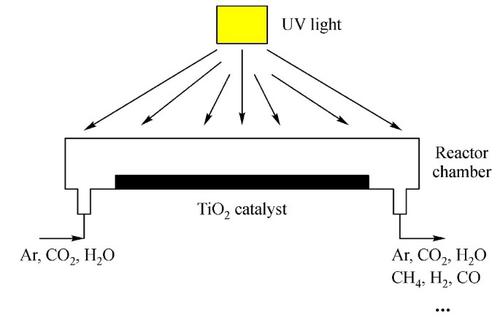Frontiers of Chemical Science and Engineering ( IF 4.3 ) Pub Date : 2021-11-02 , DOI: 10.1007/s11705-021-2096-0 Xuesong Lu 1 , Xiaojiao Luo 1 , Warren A. Thompson 1 , Jeannie Z. Y. Tan 1 , M. Mercedes Maroto-Valer 1

|
The production of solar fuels via the photoreduction of carbon dioxide to methane by titanium oxide is a promising process to control greenhouse gas emissions and provide alternative renewable fuels. Although several reaction mechanisms have been proposed, the detailed steps are still ambiguous, and the limiting factors are not well defined. To improve our understanding of the mechanisms of carbon dioxide photoreduction, a multi-physics model was developed using COMSOL. The novelty of this work is the computational fluid dynamic model combined with the novel carbon dioxide photoreduction intrinsic reaction kinetic model, which was built based on three-steps, namely gas adsorption, surface reactions and desorption, while the ultraviolet light intensity distribution was simulated by the Gaussian distribution model and Beer-Lambert model. The carbon dioxide photoreduction process conducted in a laboratory-scale reactor under different carbon dioxide and water moisture partial pressures was then modeled based on the intrinsic kinetic model. It was found that the simulation results for methane, carbon monoxide and hydrogen yield match the experiments in the concentration range of 10−4 mol·m−3 at the low carbon dioxide and water moisture partial pressure. Finally, the factors of adsorption site concentration, adsorption equilibrium constant, ultraviolet light intensity and temperature were evaluated.
中文翻译:

通过计算流体动力学和反应动力学模型研究实验室规模光反应器中的二氧化碳光还原过程
通过氧化钛将二氧化碳光还原为甲烷来生产太阳能燃料是控制温室气体排放和提供替代可再生燃料的有前途的过程。虽然已经提出了几种反应机制,但详细步骤仍然不明确,限制因素也没有明确定义。为了加深我们对二氧化碳光还原机理的理解,我们使用 COMSOL 开发了一个多物理场模型。这项工作的新颖之处在于计算流体动力学模型结合新型二氧化碳光还原本征反应动力学模型,该模型基于气体吸附、表面反应和解吸三个步骤建立,而紫外光强度分布模拟为高斯分布模型和 Beer-Lambert 模型。然后基于固有动力学模型对在实验室规模的反应器中在不同二氧化碳和水湿分压下进行的二氧化碳光还原过程进行建模。发现甲烷、一氧化碳和氢气产率的模拟结果与实验在 10-4 mol·m -3在低二氧化碳和水湿分压下。最后,对吸附位点浓度、吸附平衡常数、紫外光强度和温度等因素进行了评价。











































 京公网安备 11010802027423号
京公网安备 11010802027423号